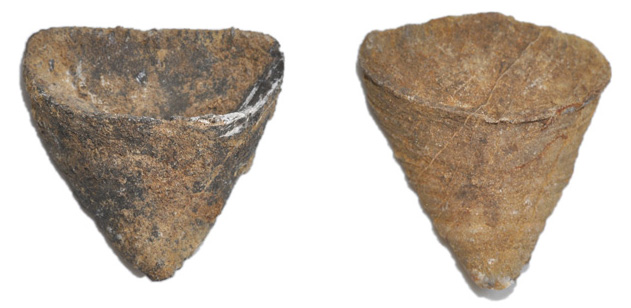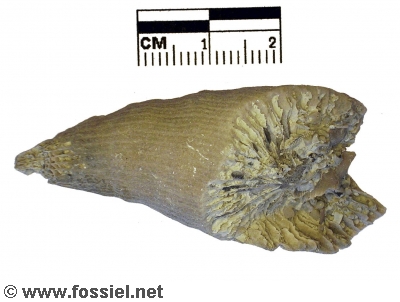Anthozoa
De Anthozoa, met onder meer de koralen en zee-anemonen, vormen een klasse binnen het Phylum Cnidaria. Fossiele vertegenwoordigers zijn gekend van voor het Cambrium tijdperk. Vooral de koralen worden als fossiel zeer vaak aangetroffen in voormalig (sub)tropische mariene sedimenten. Koralen zijn kolonies van poliepachtige diertjes die voornamelijk in tropische zeeën voorkomen. Door ongeslachtelijke deling ontstaan uit één koraalkelkje gehele kolonies, welke hele riffen kunnen opbouwen. Ook in koudere wateren komen ze voor, maar ze bouwen daar zelden riffen op.

Calceola sandalina, een herkenbaar solitair koraal uit het Devoon van België
De meeste fossiele koralen behoren tot de ordes van de Rugose, Tabulate en Scleractine koralen.Tabulate koralen zijn altijd kolonievormend, maar rugosekoralen komen vaak solitair voor. Het skelet bestaat uit calciet (kalk). Vanaf het Ordovicium tot het uitsterven aan het einde van het Perm tijdperk leefden de rugose en tabulate koralen.
De Scleractine koralen ontwikkelden zich vanaf het Midden-Trias en tot op heden zijn zij de voornaamste rifvormers. Hun skelet bestaat uit aragoniet (snel oplosbare kalk) dus vinden we meestal alleen steenkernen en afdrukken. In de fossielen zijn meestal de kamertjes waar de koraalpoliepjes hebben geleefd goed te zien.

Voorbeeld van een rugose koraal
Binnen de Benelux worden koralen in tal van fossielhoudende mariene afzettingen aangetroffen. Het meest prominent zijn de riffen in het Devoon en Carboon van België, welke vaak commercieel worden uitgebaat voor de productie van natuursteen.
Foto's of locaties voor Anthozoa bekijken
Feedback
Doneer
Wij zijn geheel afhankelijk van donaties. Daarom vragen wij onze gebruikers ons te helpen.


